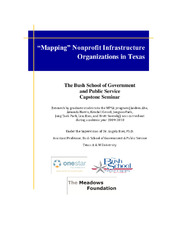| dc.description.abstract | The stability of the nonprofit sector and its ability to meet our nation‘s needs in an era of unprecedented challenges requires a solid nonprofit infrastructure (Brown, et al., 2008). These organizations that comprise this infrastructure system work behind the scenes to provide nonprofit organizations with capacity-building support. However, little is known about the actual infrastructure system, especially at the state and local levels.
In order to better understand this system, student researchers from the Bush School of Government and Public Service at Texas A&M University were asked to replicate Dr. David O. Renz‘s 2008 study, ―The U.S. Nonprofit Infrastructure Mapped.‖ The Bush School study focused specifically on the nonprofit infrastructure structure in Texas by categorizing and mapping selected nonprofit organizations using the 11 roles and functions identified by Renz (2008).
This report provides a literature review of nonprofit capacity building and organizational infrastructure. In addition, the data collection and classification using Renz‘s 11 roles and functions are detailed and mapping methodology is described. Finally, the researchers offer findings, questions to consider, and recommendations for further research.
Findings from this study include:
o Urban areas had the largest concentration of infrastructure organizations. Of the 389 nonprofit infrastructure organizations, the largest concentration of organizations was located near Dallas, Houston, Austin, and San Antonio. Several non-metropolitan regions in the state are lacking similar concentrations, even after consideration of the size of the nonprofit sector or general population in the respective regions.
o Many organizations performed multiple roles and functions. In one case, one organization performed 10 functions. Many other organizations that were studied performed more than one of the 11 functions.
o A large number of infrastructure organizations provide financial support to nonprofits. More than half of the organizations analyzed were categorized as Renz‘s Function Three-Financial Intermediaries because they facilitated the collection and distribution of financial resources to nonprofit organizations. Additionally, 40.4% of the organizations were categorized as Renz‘s Function Four-Funding Organizations because they provided financial resources to nonprofit operating organizations through the distribution of funds from asset pools that they own, manage, and allocate. Future research needs to be
Page 4
conducted, however, to determine what proportion of funding is devoted to funding of the other nine Renz categories versus funding to nonprofits providing direct services. It would be useful to consider and respond to categories lacking in such funding, relative to the infrastructure needs of Texas nonprofits generally and also in particular regions of Texas or nonprofit subfields.
o Some infrastructure functions were not as apparent. Researchers found that two of Renz‘s functions (Function One-Accountability and Regulation and Function Ten-Research) were performed by less than 5% of the organizations that were analyzed.
Recommendations that emerged from this study were:
o Regular updates of nonprofit information are important for future research. Nonprofit managers need to be educated about the importance of updating their organization‘s publicly available information. If their website or GuideStar reports are not current, researchers,practitioners, and other constituents cannot accurately analyze the organization.
o Nonprofits need to clarify their roles using Renz’s 11 roles and function. Organizations with a mission to support the nonprofit sector should clarify their focus based on the definitions of capacity-building and infrastructure developed by Renz (2008). Do the organizations intend to support the entire nonprofit infrastructure in Texas or only support Function Nine-Capacity Development and Technical Assistance?
o Strengthen associations of nonprofit infrastructure organizations throughout the Texas. This action will benefit nonprofit organizations through improved communication among infrastructure organizations, as well as economies of scale and scope.
o Facilitate the creation of a network of representatives from each Council of Governments (COG). This organization can serve as a point of contact for matters about the nonprofit infrastructure of that COG. | en |


